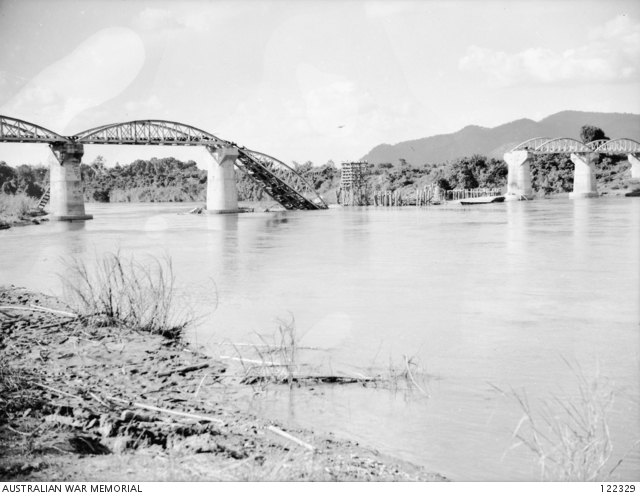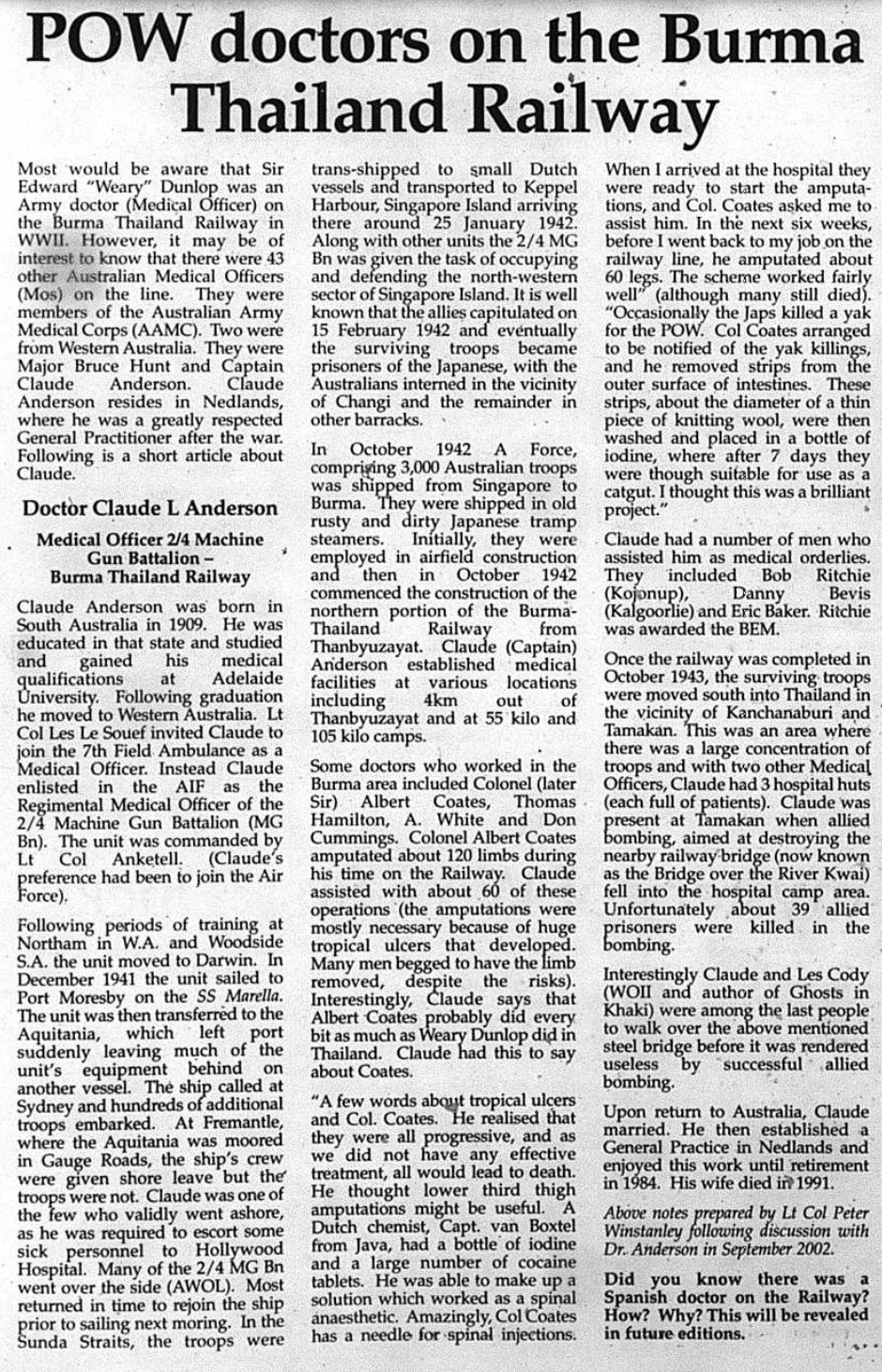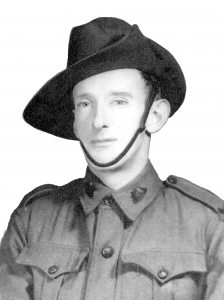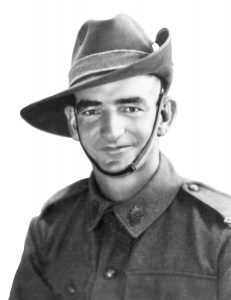Captain (Doctor) Claude L Anderson WX3464

Medical Officer 2/4 Machine Gun Battalion – Burma Thailand Railway
Claude Anderson was born in South Australia in 1909. He was educated in that state and studied and gained his medical qualifications at Adelaide University. Following graduation he moved to Western Australia. Lt Col Les Le Souef invited Claude to join the 7th Field Ambulance as a Medical officer. Instead Claude enlisted in the AIF as the Regimental Medical Officer of the 2/4 Machine Gun Battalion (MGBn). The unit was commanded by Lt Col Anketell. ( Claude’s preference had been to join the Air Force).
Following training at Northam in W.A. and Woodside S.A. the unit moved to Darwin. In December 1941 the unit sailed to Port Moresby on the SS Marella. The unit was then transferred to the Aquitania, which left port suddenly leaving much of the unit’s equipment behind on another vessel. The ship called at Sydney and hundreds of additional troops embarked. At Fremantle, where the Aquatania was moored in Gauge Roads, the ships crew were given shore leave but the troops were not. Claude was one of the few who validly went ashore, as he was required to escort some sick personnel to Hollywood Hospital. Many of the 2/4 MGBn went over the side (AWOL). Most returned in time to rejoin the ship prior to sailing next morning. In the Sunda Straits, the troops were trans shipped to small Dutch vessels and transported to Keppel Harbour, Singapore Island arriving there around 25 January 1942. Along with other units the 2/4 MGBn was given the task of occupying and defending the northwestern sector of Singapore Island. Claude was mentioned in dispatches for his medical support of the soldiers during the battle for Singapore. It is well known that the allies capitulated on 15 February 1942 and eventually the surviving troops became prisoners of the Japanese, with the Australians interned in the vicinity of Changi and the remainder in other barracks.
In May 1942 A Force, comprising 3000 Australian troops was shipped from Singapore to Burma. They were shipped in old rusty and dirty Japanese tramp steamers. Initially, they were employed in airfield construction and then in October 1942 commenced the construction of the northern portion of the Burma-Thailand Railway from Thanbyuzayat. Claude (Captain) Anderson established medical facilities at various locations including 4km out of Thanbyuzayat and at 55 kilo and 105 kilo camps. Some of the doctors who worked in the Burma area included Lieutenant Colonel (later Sir) Albert Coates. Thomas Hamilton and Don Cummings. Colonel Albert Coates amputated about 120 limbs during his time on the Railway. Claude assisted with about 60 0f these operations (the amputations were mostly necessary because of huge tropical ulcers that developed. Many men begged to have the limb removed, despite the risks). Interestingly, Claude says that Albert Coates probably did every bit as much as Weary Dunlop did in Thailand. Claude had this to say about Coates.
“A few words about tropical ulcers and Col. Coates. He realised that they were all progressive, and as we did not have any effective treatment, all would lead to death. He thought lower third thigh amputations might be useful. A Dutch chemist, Capt. Van Boxtel from Java, had a bottle of iodine and a large number of cocaine tablets. He was able to make up a solution which worked as a spinal anaesthetic. Amazingly, Col Coates had a needle for spinal injections. When I arrived at the hospital they were ready to start the amputations and Col. Coates asked me to assist him. In the next six weeks, before I went back to my job on the railway line, he amputated about 60 legs. The scheme worked fairly well” (although many still died). “Occasionally the Japs killed a yak for the POW. Col Coates arranged to be notified of the yak killings, and he removed strips from the outer surface of intestines. These strips, about the diameter of a thin piece of knotting wool, were then washed and placed in a bottle of iodine, where after 7 days they were thought suitable for use as catgut. I thought this was a brilliant project”.
Claude had a number of men who assisted him as medical orderlies. They included Bob Ritchie (Kojonup), Danny Bevis (Kalgoorlie) and Eric Baker all from 2/4th MGBn. Ritchie was awarded the BEM.

Ritchie, Bevis & Baker
Once the railway was completed in October 1943, the surviving troops were moved south into Thailand in the vicinity of Kanchanaburi and Tamakan. This was an area where there was a large concentration of troops and with two other Medical Officers, Claude had 3 hospital huts (each full of patients). Claude was present at Tamakan when allied bombing, aimed at destroying the nearby railway bridge(now known as the Bridge over the River Kwai) fell into the hospital camp area. Unfortunately about 39 allied prisoners were killed in the bombing.

Interestingly Claude and Les Cody (WOII and author of Ghosts in Khaki) were among the last people to walk over the above mentioned steel bridge before it was rendered useless by successful allied bombing.
Some facts about Claude:
He established his combined medical practice/house on Stirling Highway in Nedlands so that his patients had easy access with the ‘trolley buses;. Like all doctors in a solo practice, Claude was on call during the night for emergencies as well as completing his daily house calls and surgery appointments. It was a demanding life especially when he delivered babies during the night.
Claude’s family consisted of his wife Florence, their twins, Bruce and Margaret, and Florence’s son, Alister. When asked about Alister, Claude gave the following information. While working as a young doctor in Adelaide, he met Florence McGlip, a trainee nurse. However, as he was moving to Perth to accept a posting in medicine at the Royal Perth Hospital in 1935, he was not prepared to enter a binding relationship. They remained good friends.
Soon after finishing her training, Florence and her sister Mary, went on a world sight seeing trip to England and Europe. On board the ship, she met Alister Turner, an English naval doctor who was returning to England from the Middle East. This shipboard romance resulted in their marriage later in Adelaide. When returning to England, their ship arrived in Fremantle and they called on Claude. In England, Alister went into private practice with his father, also a doctor. The couple had a baby son, Neil Alister, born in September 1939.
When the War began, Alister was recalled to Royal Naval duties. Sadly, he lost his life in the evacuation of Dunkirk in 1940 when his ship, HMS Keith, was torpedoed and sunk. Florence returned to Adelaide with her baby on the last ship returning to Australia.
In Perth, Claude had already enlisted in the Australian Medical Corps and he became a Prisoner of War for three and a half years with the fall of Singapore. After the war ended, Claude remained in Thailand along with a number of other Medical Officers to tend to sick and frail soldiers.
When released from the prisoner of war camp, Claude corresponded with his family and learned that Florence had returned to Adelaide. As a result of this information he also corresponded with her. He got to know that Alister through pictures and letters about him. He returned to Adelaide on 5/11/1945 and married Florence two days later. Claude often chuckles when he recalls how Florence met him – ‘You’re getting married in two days!’ She reckoned that being widowed and he a POW for so long, the sooner the better. The couple with Alister, then 6 years old, returned to Perth as a family and lived in Nedlands.
Claude refused to change Alister’s surname to Anderson, saying that he should retain the Turner name in honour of his brave father.
Claude and Florence were happily married for 45 years until Florence’s death in 1991.
In 2006 Claude (aged 96) lived in Nedlands, Western Australia.
These notes were prepared by Lt Col Peter Winstanley OAM RFD JP following discussions with Dr Anderson, September 2002.
From The Listening Post – August 2003



